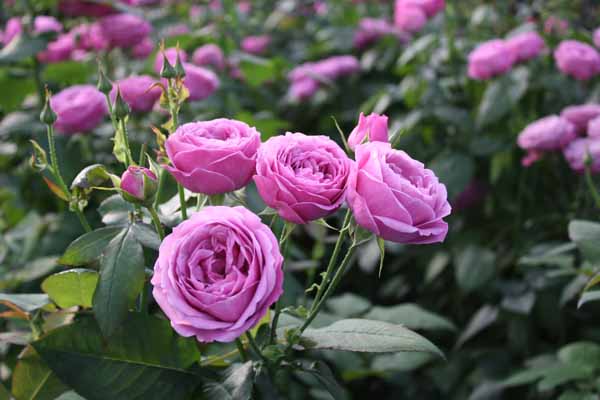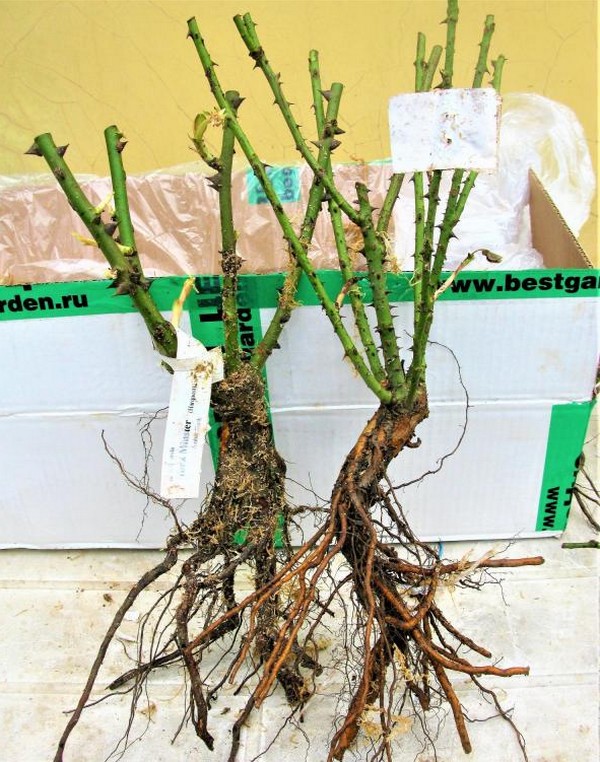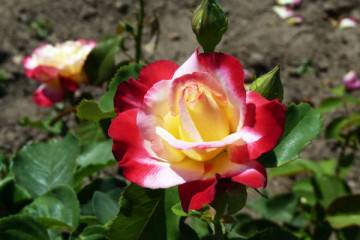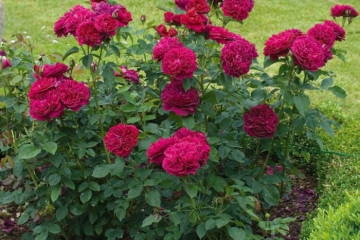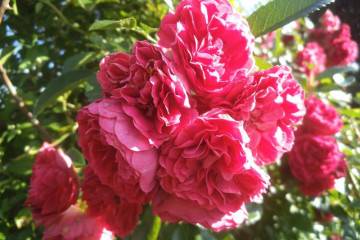Rose Misty Bubbles - description of the decorative variety
Content:
It is impossible to remain indifferent to this extraordinary and amazingly beautiful rose. Misty Bubbles is the name given by the creators, breeders of the famous Dutch company De Ruiter, which has been developing new varieties since 1945. The name is translated from English as "magic bubbles".
Description and characteristics of the variety
Spray Rose Misty Bubbles is a representative of the Bubbles series of spray roses. A compact bush 60-80 cm high and 50-60 cm wide, thanks to repeated flowering, it is decorative throughout the season - from mid-June to October. Flowers stand well in cut: with proper maintenance, up to two weeks. Therefore, the plant can be used both for garden decoration and for bouquets.
Flowers ranging in size from 6 to 8 cm have a spherical or peony-shaped shape that is not quite usual for roses and an exquisite pinkish-lilac color. On one shoot, from 5 to 15 densely double flowers, containing from 35 to 70 petals, bloom with a light spicy aroma. The buds of the Misty Bubbles bush rose open gradually. Flowers do not droop and do not rot from rain, do not fade in the sun. There are few thorns on the shoot.
Use in landscape design
In the garden, the rose looks gorgeous like a tapeworm, for example, against the backdrop of a green lawn. She will not be lost in flower beds. Given its small size, Misty Bubbles can be planted in the foreground in rose gardens. Spectacular pink-lilac spots are obtained when the bushes are placed in groups of 3-5 specimens. With its unusual peony-shaped flowers, the Bubbles rose is ideal for creating monochrome flower gardens. Looks exquisite in combination with purple or dark blue candles of delphiniums, aconite, liatris, sage.
Growing roses in the open field
Strong healthy seedlings for growing this variety are best purchased in specialized shopping centers working with trusted reliable suppliers. You can contact the seedling growers directly at well-known rose-growing companies.
Having been tempted by cheap seedlings, you can run into unscrupulous sellers and get a completely different one instead of the expected variety.
Sapling selection
In order for the plant to take root and enjoy its flowering for many years, attention must be paid to the correct choice of a seedling. A quality rose seedling should have at least two lignified dark green shoots with live buds. If the shoot is brown, you need to lightly scrape the bark with your fingernail. In the case when there is no greenish color under the bark, the shoot is dried up, such a seedling should not be taken. Seedlings with broken, damaged or deformed shoots, with spots, mold or other suspicious formations on the bark, with shriveled bark are also not options for purchase.
It is necessary to examine the shoots for the presence of strong healthy living buds. Their absence is a sign of poor quality of the seedling. Also, do not buy a seedling with shoots that have started to grow. Rose seedlings are usually brought into the retail network early - at the beginning of February.In the warmth, the buds wake up and begin to grow, drawing nutrients from the roots. Such a seedling may not be viable.
As a rule, the shoots of roses are covered with wax on the outside. If you poke it slightly, it should peel off easily. Particular attention should be paid to the site of vaccination. There should be no peeling or peeling of the bark on it. This is not a cosmetic defect, but a serious plant problem.
When buying a seedling, unfortunately, it is impossible to inspect its roots, since they are most often packed in a transporting substrate and film. This procedure must be done at home. A well-developed root system has lateral and adventitious roots, as well as suction thin white roots. There should be no dry and damaged roots, mold and areas of decay.
If the seedling was purchased early, when it is still cold outside and there is snow, it is necessary to organize proper storage for it before planting. The best place is a frost-free cellar. If there is no cellar, then you need to wrap the package with the seedling in a newspaper, place it in a plastic bag and put it in the refrigerator in the vegetable compartment. If the buds have started to grow and there are green or whitish shoots, it is better to temporarily plant such a seedling in a large container (8-10 liters) with nutritious soil and grow it before transplanting into the garden in a well-lit cool place (+14 ° C-16 ° C) ...
Choosing a place for a rose
Rose loves well-lit areas of the garden. Sunlight has a beneficial effect on its growth and flowering, as well as its ability to resist fungal infection. Rose Misty Bubbles, planted in the shade under the trees, blooms poorly, its shoots are stretched, the plant often lacks nutrients and moisture. It is desirable that the place is quiet, protected from strong winds.
The soil is preferably neutral with a pH level of 6-7. In such conditions, the rose absorbs nutrients better. There should be no soil blocking. Long stay of roots in water can lead to their decay and death of the plant.
Preparing the soil and seedlings for planting
Two weeks before planting, the soil is thoroughly cleaned of weeds, roots and debris, dug up with fertilization at the rate of 1 kg of rotted manure per plant.
Before planting, the seedlings are taken out of the package, carefully freed from the transport substrate, taking care not to damage the suction white roots. A sharp pruner with disinfected blades removes broken, dry areas, renews the cuts of large roots. If areas of decay are found, they are removed to healthy tissue, and the entire seedling is placed in a fungicide solution (according to the instructions for use).
Holes are dug, the depth of which should correspond to the size of the root system of the seedling. Drainage is laid at the bottom of the hole - fine crushed stone, gravel, expanded clay. In its central part, you need to make a mound of fertile soil and install a plant on it, carefully spreading the roots in all directions. The hole is filled with a fertile mixture of earth and rotted manure or compost. The soil around the seedling is compacted. For the convenience of watering, you can form a roller of earth around the bush. Water it abundantly - up to 8-10 liters of water per plant.
Planting a seedling is carried out in such a way that the grafting site is buried 3-5 cm below the soil level. If the soil is sandy, it can be a little deeper, on clay soil - a little shallower. Leaving the grafting site above the soil level is fraught with the appearance of wild growth on the rootstock, which weakens the cultivated part of the plant.If the seedling is too deep, the neck of the plant may begin to dry out, which will lead to the death of the rose.
Sapling shoots are cut to a height of 10-15 cm above the ground. For several days, until the plant has adapted to the new conditions, it should be shaded from the bright sun.
Rose care
Watering is carried out in the evening with water warmed up in the sun. It should not be frequent, but abundant - once a week, 5-10 liters per bush. In dry weather, watered more often - twice a week. Before watering, it is advisable to gently loosen the topsoil to remove the resulting crust. After watering, the soil can be mulched.
Mulching reduces watering. As mulch, a mixture of rotted horse manure with sawdust is considered the most successful option. You can also use compost, coniferous litter, grass cuttings. Mulch not only retains moisture, but also inhibits the growth of weeds and serves as food for the rose.
Fertilization
Top dressing is carried out several times per season. In the spring, when the Mystic Bubbles rose intensively builds up its green mass, it desperately needs nitrogen. It can be a mono-fertilizer (urea, carbamide, ammonium nitrate) or a complex preparation consisting of nitrogen, potassium and phosphorus in equal amounts, as well as an organic fertilizer (rotted manure, compost, infusion of nettle leaves).
Before fertilizing, the rose must be watered abundantly, even if the fertilizer is liquid. It is better to apply nitrogen fertilizers in a dissolved form. It is not advisable to moisten the stems of roses so that there is no chemical burn. If the air temperature is below + 10 ° C, fertilizing with nitrogen fertilizers will be ineffective. They should be applied at the dosage recommended by the manufacturer. Exceeding the dose leads to a decrease in plant immunity and, as a result, contributes to the development of fungal diseases. It is better to underfeed the rose than overfeed!
During the budding period, for abundant flowering, the plant needs phosphorus and potassium fertilizers, but during flowering, feeding is stopped. The last time the phosphorus-potassium mixture is introduced is in the fall, but no later than mid-September. Phosphorus promotes the ripening of rose shoots and increases their winter hardiness.
Pruning a rose
Pruning Misty Bubbles roses begins from the first year of planting in order to properly form the bush. Young shoots, as they grow, are constantly cut off above the second or third leaf so that the upper left bud is always outside. The buds from the inside of the branches are plucked out, and the shoots growing inside the bush are cut out. It is necessary to remove wilted flowers in time, without waiting for the formation of fruits, since they weaken the flowering of the rose. The cut is made over the first full pair of leaves.
Spring pruning is carried out during a period when the frost is already behind, and the buds have not yet blossomed. Pruning very early before the end of the frost inhibits the flowering of roses. First, they carry out sanitary pruning: they remove broken, dried, podoprevny and affected shoots to healthy wood, cut out shoots growing in the center of the bush in order to dilute it. This helps to ventilate the plant, reduces the risk of developing fungal diseases. If necessary, adjust the shape of the bush. Young unripe shoots are cut out for the winter, they reduce the winter hardiness of the rose.
Shelter for the winter
This procedure is started when a stable negative temperature is established. Spruce branches are laid on the ground, shoots of roses are neatly bent down on it, pinned to the ground with metal hooks.A frame is formed on top. For this, arcs for a greenhouse or wooden slats are used. The entire structure is covered with a double layer of dense covering material, the edges of which are fixed with heavy objects (stones, bricks, etc.). It is not recommended to use plastic wrap for shelter - it helps the roses damp out.
In the spring, the shelter is removed gradually, preferably on a cloudy day. First, they are lifted from the edges. At this time, it is important to protect the rose shoots from the bright spring sun. If the ground has not thawed yet, the roots have not begun to work, and the buds from the heat and the sun have already woken up and started to grow, there is an imbalance between the need for the aboveground part of the rose and the possibility of roots. The roots cannot provide the rose with everything it needs, it turns black and dies. You can make the roots work by pouring hot water on the ground around the rose.
Rose transplant
A Misty Bubbles rose transplant can be done in the spring or fall in September so that the rose has time to adapt and prepare for winter. Transplanting a rose in hot dry weather in summer is not recommended. It is better if the roses did not grow in the new place, otherwise soil replacement will be required.
The bush is carefully dug out, being careful not to damage the roots. If, nevertheless, this happened, the broken area is removed, the cut is treated with crushed coal. The roots are washed and placed in a fungicide solution to remove the fungal infection. Since the rose is small, its root system is not very extensive, it is enough to prepare a hole 50x50x50 cm in size. Drainage is placed at the bottom of the hole, then a mound of a mixture of earth and rotted manure is poured, you can add a handful of complex mineral fertilizer. The roots of the rose are placed on the mound, carefully spreading them in different directions and covered with fertile soil. The ground around the plant is tamped so that no air pockets remain, and watered abundantly. The vaccination site should be 3-5 cm below the surface of the earth.
Bloom
Shrub rose Misty Bubbles belongs to the re-flowering species. With proper planting and proper care, it blooms profusely from mid-June to almost snow.
A decrease or absence of flowering may be associated with a violation of agricultural technology:
- poorly chosen landing site;
- irrigation regime is not observed;
- overfeeding with nitrogen fertilizers (rose fat).
You can try to make the rose bloom by cutting off the blind shoots by 3-5 buds. Sometimes diseases are the cause of the weakening of the bush.
Reproduction
The best way to propagate a Misty Bubbles rose is by cuttings. For this purpose, take annual semi-lignified shoots approximately the size of a pencil. Soft herbaceous, as well as too lignified shoots are unsuitable for propagation by cuttings. The most successful time is the second half of June, when buds appear on the rose in the stage of staining.
Cuttings are cut from healthy shoots. Each stalk should have 3-4 internodes. The lower cut is made oblique under the lower kidney, the upper one is horizontal, 1 cm above the upper kidney. The leaves are removed, leaving only the top pair. The stalk is dipped in powder of a root formation stimulator (Kornevin, Heteroauxin) and placed in a wet substrate (a mixture of earth and sand) to a depth of 1 cm. A greenhouse is built over the stalk in the form of a cut plastic bottle, glass jar or cellophane bag. Make sure that the substrate does not dry out. First, an influx appears in the lower part of the cutting - callus, then roots sprout from it. When the young plant gets stronger, it is transplanted into the garden.
Diseases and pests
Lack of light, cold rainy weather, overfeeding with nitrogen fertilizers contribute to the development of fungal diseases of roses. Remains of dead and diseased plants, contaminated soil are sources of infection:
- Powdery mildew appears as a white-gray coating on the green parts of plants. The affected areas of the plant turn black and die off.
- Black spot appears in late summer with black and brown spots on the leaves.The leaves dry up and fly around.
- Rust appears on the shoots in the spring in the form of an orange dusty bloom. Later on the leaves below you can find small cushion-shaped formations of yellow-orange color.
Ways to fight:
- Collection and disposal of contaminated residues.
- Treatment with iron sulfate and copper-containing preparations in early spring or autumn.
Insect pests
They are divided into gnawing and sucking. Gnawing pests violate the integrity of the parts of roses: they eat the flesh of the leaves, eat out the passages inside them, gnaw through the passages in the stems, damage the buds and flowers, destroy the pistils and stamens. These include leaf rollers, rose sawers, bronze and deer.
Ways to fight:
- Manual collection of adults.
- In the spring, insecticide treatment.
Sucking pests pierce the tissues of plants and suck out the cell sap, which leads to the death of the leaves. This can be done by rosy aphids, rosé leafhoppers, slobbering pennits, spider mites. To combat them, the bushes must be treated with insecticides.
Rose Misty Bubbles is incredibly beautiful and unusual. All the efforts made in growing it will be rewarded with lush and long flowering.

